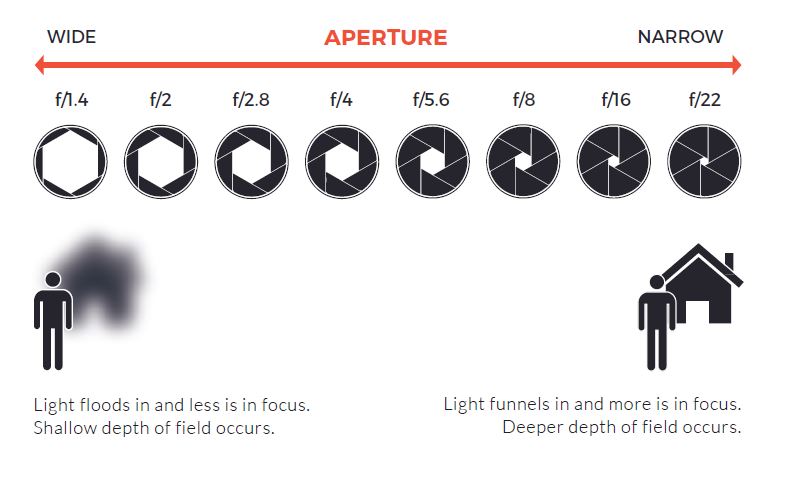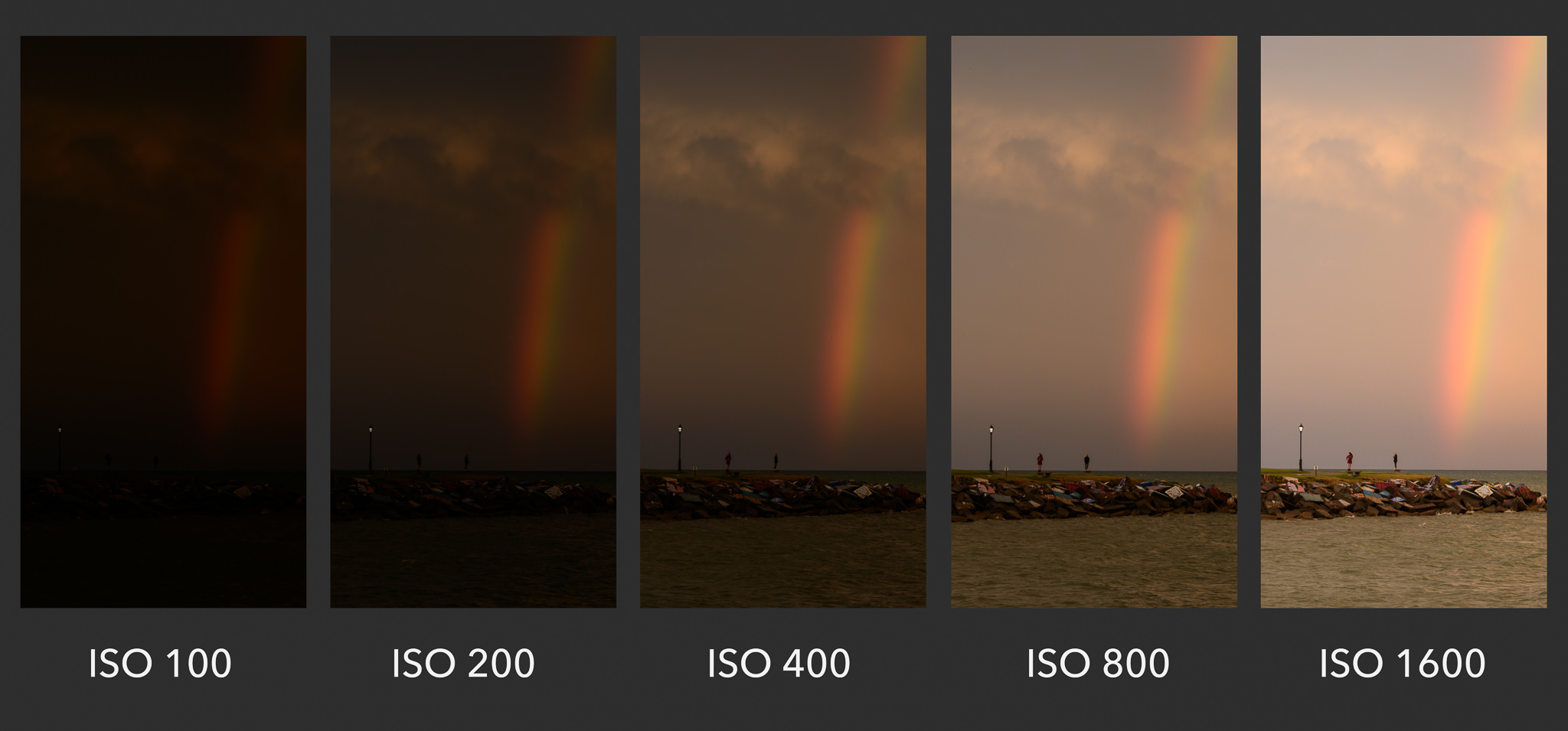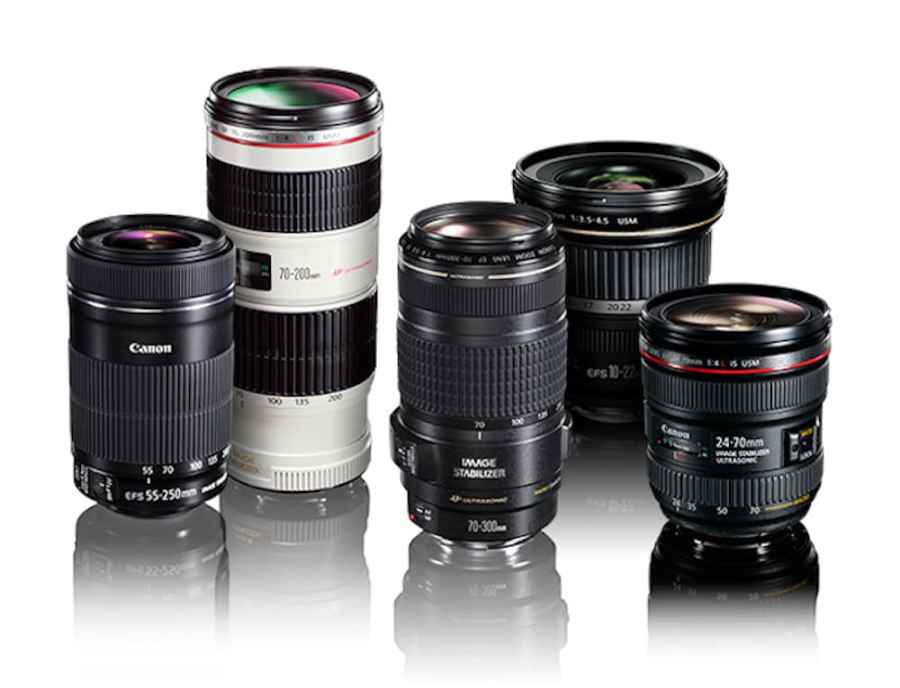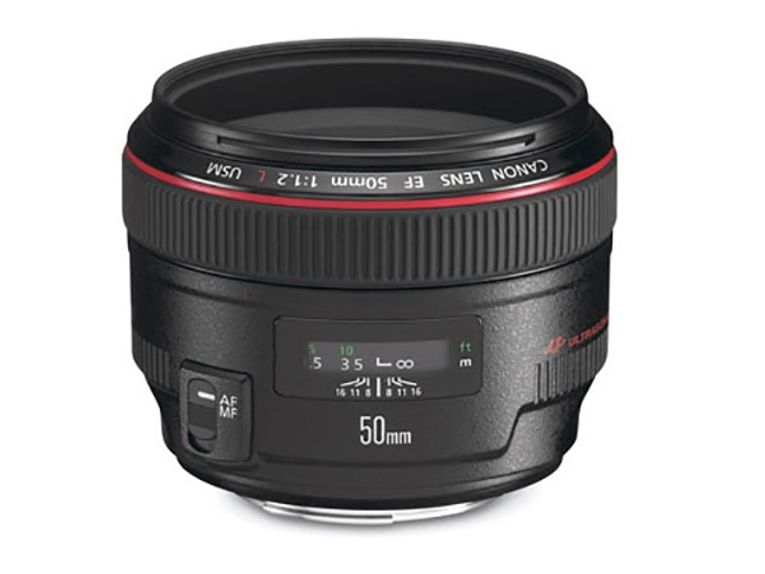This lesson, we were taught about Aperture, Shutter Speed and ISO. These three settings all affect the brightness of your image and the quality.

Aperture: The hole in the lens that ligtht travels into the camera. The larger the hole is the more light passes to the camera sensor. If the aperture is small, the depth of field is large meaning a bigger portion of the scene is sharper. Vice versa, if the aperture is large , the depth of field is small. Usually represented as “f”.


Shutter Speed: The length of time the camera shutter is open in order for light to be exposed into the camera sensor. Slow shutter speeds are used in night photos or in low light to allow for more light to his the camera sensor. Fast shutter speeds help to freeze motion. Example of shutter speed: 1/30, 1/15, 1,100

ISO: Used as an alternative to brightening up your photos if you cant use a longer shutter speed or wider aperture. Usually measured in numbers, a lower number to represent daa darker image , while higher numbers mean a brighter image. However, when raising your ISO you also raise the visibility of the graininess/noise in your images. Examples of ISO: 100,200,300,400,etc


WEEK 3
Perspective and lens Angles of views
Prime lenses – a fixed focal length lens that doesnt let you zoom in or out. Wide apertures and higher image quality.
Zoom lenses – a system of camera lens elements for which the focal length can be varied.

CAMERA ANGLES
Each camera angle and its importance:
Extreme Long/wide Shot – Capturing a subject from a long distance, usually used to make it appear smaller in comparison to its location. You can use this shot type to capture the location.
Long Shot – similiar to extreme long shot except a little closer. Usually whole subject will be much more viewable but still not taking up the entirity of the shot.
Full shot – Entire subject is captured within the frame from head to toe and the subject usually occupies most of the frame without much space above or below them.Full shots are useful for showing the subject’s physical presence and body language. They provide context and help establish the spatial relationship between the subject and their surroundings.
Medium Wide Shot –A medium wide shot frames the subject from the knees or waist up, allowing more space around the subject than a medium shot but not as much as a full shot. Medium wide shots offer a balance between showing the subject and their surroundings. They provide enough detail to convey action or expression while still maintaining a sense of environment.
Cowboy Shot – The cowboy shot frames the subject from mid-thighs up, typically including the holster and guns of a cowboy. It’s named after its frequent use in classic western films. Cowboy shots are often used in westerns to depict confrontations or gunfights. They emphasize the weapons carried by the characters and add tension to the scene.
Medium Shot – In a medium shot, the subject is framed from approximately the waist up. This shot typically focuses on the upper body and facial expressions.Medium shots are versatile and commonly used for dialogue scenes or interactions between characters. They allow for clear communication of emotions and actions without being too close or too distant.
Medium Close Shot – A medium close shot frames the subject from the chest or shoulders up, emphasizing facial expressions and details while still showing some of the surrounding environment.Medium close shots are often used for intimate or emotional moments, providing viewers with a closer look at the character’s emotions and reactions.
Close up Shot – In a close-up shot, the subject fills the frame, typically from the shoulders or neck up. This shot focuses intensely on facial expressions, details, or specific objects.Close-up shots are powerful for capturing emotions, reactions, or significant details. They draw viewers’ attention to specific elements and can evoke strong emotional responses.
Extreme Close up– An extreme close-up shot zooms in on a very small detail or portion of the subject, such as the eyes, mouth, or hands. The subject often fills the entire frame, leaving no space for the surroundings.Extreme close-ups are used to highlight minute details or intensify emotions. They create a sense of intimacy and can convey specific emotions or thoughts through subtle facial expressions or gestures.
CAMERA MOVEMENTS
Camera movement refers to the physical motion of the camera during filming. Camera movement adds dynamism, depth, and visual interest to a scene, guiding the viewer’s attention, conveying mood, and enhancing storytelling.
Examples of types of camera movements in film:
Pan: refers to the horizontal movement of the camera from left to right or right to left while keeping its orientation fixed. It involves rotating the camera on its vertical axis. Panning is commonly used to reveal new elements within a scene or to follow the movement of a subject across the frame. It can also be used to establish the spatial relationship between different elements in the scene or to create a sense of continuity between shots.
Tilt: Tilt involves the vertical movement of the camera, either upward or downward, while keeping its horizontal orientation fixed. It entails rotating the camera on its horizontal axis.Tilting is often used to reveal vertical elements within a scene, such as tall buildings or towering landscapes. It can also be employed to emphasize the height or depth of a subject or to create dramatic effect, such as revealing a character’s facial expression or reaction.
Push in: Pushing in, also known as zooming in, involves moving the camera closer to the subject by adjusting the focal length of the lens or physically moving the camera forward. This creates the illusion of the subject becoming larger or filling more of the frame.Pushing in is used to draw the viewer’s attention to specific details or emotions within a scene. It can intensify the focus on a character’s face or actions, heightening the emotional impact of the moment. Pushing in gradually can also build tension or suspense, leading to a climactic reveal or revelation.
Pull out ( Zoom out ) :Pulling out, also known as zooming out, involves moving the camera away from the subject by adjusting the focal length of the lens or physically moving the camera backward. This creates the illusion of the subject becoming smaller or receding within the frame. Pulling out is used to provide context, reveal the broader environment or setting, or to transition from a close-up or intimate shot to a wider perspective. It can create a sense of space or scale, showing the relationship between characters and their surroundings.
Tracking shot: A tracking shot involves moving the entire camera along a predetermined path, usually on a wheeled platform called a dolly. It can be used to follow a moving subject, explore a space, or create a sense of fluid movement within the scene.Tracking shots add dynamic motion to a scene, allowing the camera to smoothly follow characters or objects as they move through the frame. They provide a sense of immersion and continuity, enhancing the cinematic experience for the viewer. Tracking shots can also convey a character’s perspective or point of view as they navigate their surroundings.
Here are some examples my classmates captured:

This is an example of a long shot.
(Photographer- Angel Stoyanov)
ASSIGNMENT 1
I decided to base my assignment around a resentful psychopathic woman who has urges to murder her husband. She is overwhelmed by these ideas but she is still unsure. She visits a gallery where she is immediately inspired by the artwork of strong, powerful past authorative figures. She can’t help but be envious of their power, especially that of the women, since she is so deprived of it when being with her husband. Thinking that getting rid of him would give her the sense of power she so desperately craves, she uses a screwdriver to murder her husband in cold blood.
 PHOTO 1 – Gazing out the window, thinking about her life and what she can do to take back control.
PHOTO 1 – Gazing out the window, thinking about her life and what she can do to take back control.
PHOTO 2: After reflecting, she gets the idea to explore a museum.
 PHOTO 3 -Wandering through the gallery, she notices a potrait of an authorative figure.
PHOTO 3 -Wandering through the gallery, she notices a potrait of an authorative figure.

PHOTO 4 – this inspired her in a way. She sits down and contemplates.  PHOTO 5 –
PHOTO 5 –
She recognises another significant individual, but this time it’s a woman, which means even more to her, as she yearns to experience female empowerment.

PHOTO 6:She realises that the way to gain back control is to to get rid of the husband completely, by killing him.

PHOTO 7 –
She kills him mercilessly , behind his back with a screwdriver, feeling a great sense of relief, strength, and pride.

PHOTO 7 – She feels overcome with satisfaction. I purposely chose a dark backdrop to contrast with the vibrant red lipstick to connote evil, death and blood.

PHOTO 8: I chose a bright red light on the side of my face to symbolise that there is an evil side to the character that has been hidden. 
PHOTO 9 – This image captures the dark aspect of the character’s feminine nature. She utilises seduction, symbolised by the red lipstick, to entice her husband into falling victim to her murderous scheme. I enhanced the red’s contrast with the picture’s dark tones using Lightroom.  PHOTO 10- This is a full body shot showing the character’s lack of emotion for her heinous acts. Not only that but seems to be enjoying it in a pyschotic manner.
PHOTO 10- This is a full body shot showing the character’s lack of emotion for her heinous acts. Not only that but seems to be enjoying it in a pyschotic manner. 
PHOTO 11
ASSIGNMENT 2 – Portraits
Cyberpunk Themed



